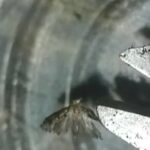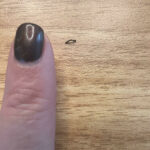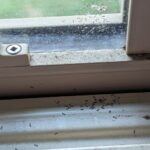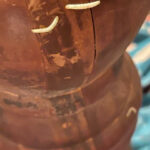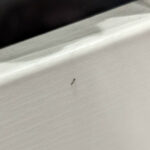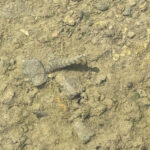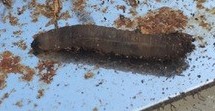
“I found other pictures that look like these and you said it was a moth”, writes this reader about the tiny, gray, worm-like creatures pictured below. “I’m interested in knowing what kind of moth larvae they are, and whether wiping it off got rid of them, or if I need to bomb them, hire an exterminator, etc. I’m looking for recommendations on the process and what products would be helpful to ensure they don’t come back. Your site is very helpful.” To start with, we want to thank our reader for the compliment: we always aim to be as helpful as we can, and we hope we can provide that same service to her. Now, there is a lot to unpack here, so we will just address each part of our reader’s submission in turn.
Firstly, while we do not know exactly which article she refers to, we will agree that these are moth caterpillars. Emphasis on ‘caterpillars’. These are not fully-grown moths, as they would have wings, and they would not congregate in this way. Specifically, we think these are newly-hatched American ermine moth caterpillars, though they could also be newly-hatched armyworms, as the two species look very similar at this stage of their life.
Secondly, when it comes to “getting rid of” the caterpillars, we neither recommend wiping nor bombing, or hiring an exterminator. The only instances in which we recommend killing organisms is if an infestation is likely to take place that will cause significant disruption or stress to the lives of the people experiencing it, or if the organism is potentially dangerous in any way. And while there is a high number of caterpillars present in this instance, we could hardly call it an infestation. The only reason American ermine moths lay their eggs inside a home is because it provides a stable and safe environment for the eggs to hatch. Both American ermine moth caterpillars and armyworms eat plants found outside, and would have no interest in anything inside the home. What we recommend doing is gently scooping the caterpillars onto a dustpan and moving them outside.
Lastly, when it comes to what “products” we recommend, there are none. The “process” of getting rid of these caterpillars should consist only of moving them outside. They have no reason to come back inside, save for warmth (and in that case it might be a good idea to move them a bit away from the house). Of course, in general, there are things you can do to prevent invasions of a number of insects and small organisms, such as sealing cracks in floors and walls, ensuring that one’s window screens are intact (and if not, replacing them), and keeping one’s home clean. Additionally, we assume when our reader writes “products”, she means insecticides and the like. We never recommend using insecticides, as they do more harm than good: the chemicals in insecticides are harmful to humans and pets, and spraying them will just get those chemicals all over the home.
To conclude, we think our reader found American ermine moth caterpillars. There are only so many of them because they recently hatched, so moving them outside should eliminate the ‘infestation’. They are not to be feared, and we do not recommend killing them. We hope this helps, and we wish our reader the very best!
All About Worms is always free, always reader-supported. Your tips via CashApp, Venmo, or Paypal are appreciated! Receipts will come from ISIPP Publishing.
You might also find these guys interesting!




